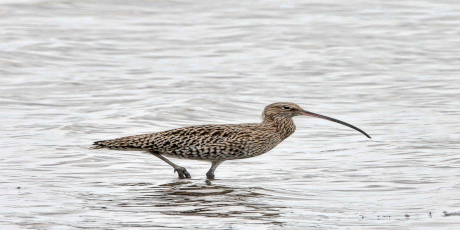Research reveals climate change is driving endangered Irish birds to new habitats 21 Sep 2023

- Endangered Curlew is changing it winter habitats in response to climate change.
- Industrial estates, sports fields, agricultural sites near the coast among newer, more vulnerable habitats for Curlews.
- Researchers fear movements away from more natural habitats will accelerate population decline
The impact of changing winter climate is driving an endangered bird native to Ireland to areas with higher percentage of previously avoided habitats such as industrial sites and sports fields, according to new research.
The long-term habitat use of the endangered Curlew in the UK and Ireland is outlined in new research by UCC, Aberystwyth University, the British Trust for Ornithology and Geo Smart Decisions.
Several unexpected habitats used by the Curlew were revealed by the research team, with the birds geographic range constrained by landscape and weather. Researchers fear that the Curlew’s movement to a wider range of locations, further away from its natural habitat, will accelerate the decline in their population.
Areas used by wintering Curlew included those with a higher percentage of salt marshes, mud flats, and estuaries, but also sports fields, industrial sites, and agricultural fields, which increases their vulnerability as these areas may create more human-wildlife conflict.
“We used a relatively novel approach to compare the habitat and weather at locations used by wintering Curlew over nearly two decades” said Dr Kim Kenobi, researcher at Aberystwyth University and lead author of the article. “By reducing very complex landscapes using these state-of-the-art methods, we have identified the key habitats that wintering Curlew are using, and importantly when they are using these, which will ultimately support conservation efforts for this vulnerable species”.
Populations of breeding Curlew are declining rapidly, and there is a real concern that the species may go extinct in our lifetime; however, curlew mortality is higher in the winter months, particularly in young birds and this research is the first regional scale analysis of their wintering distribution and habitat use.
“It's critical that we understand how declining birds like Curlew use the landscapes they need to survive” said Dr Callum Macgregor, researcher at the British Trust for Ornithology. “The winter months are a pinch point in a Curlew's life cycle so identifying and protecting the habitats this threatened species uses is crucial for its conservation, particularly in light of threats from development and climate change. We are grateful to the volunteers who collect long-term national datasets like those used in this study. Their help is key to unlocking the knowledge we need to protect our most endangered wildlife.”
The research reveals that extreme weather events, such as frost events restricted the geographic areas the birds could use and resulted in Curlew using different habitats throughout the winter.
These findings could provide insight in mitigating the negative impacts of climate change and habitat loss on one of our most vulnerable bird species.
“February was a particularly interesting month, as Curlew appeared to use a much wider range of habitats. These movements increase their risk of mortality as it takes them away from their natural habitat, which further impacts population decline as there are less birds returning home to breed each spring” said Dr Paul Holloway, researcher at the ERI and UCC School of Geography. “Identifying this consistent pattern over the last 20-years, we can predict where birds are likely to be, and importantly when they are going to be there, which helps us promote their safety and wellbeing on their final leg of migration.”
The research is published in the journal Ecological Informatics.
This research is part of the ECHOES project. ECHOES is funded through the INTEREG Ireland-Wales Programme 2014-2020 and part-funded by the European Regional Development Fund through the Welsh Government.
Photo credit: Luke Lambert